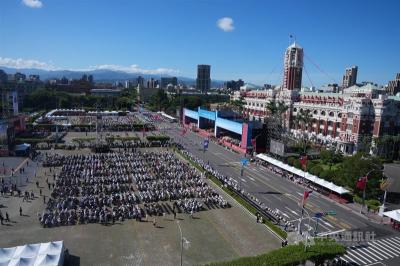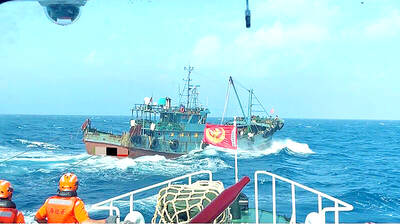Thousands of Philippine and US soldiers began annual war games yesterday, the first under a new security pact with the US, focusing on maritime security in the face of China’s growing naval presence in the disputed South China Sea.
The “Balikatan” (shoulder-to-shoulder) joint exercises would test the combat readiness of the two allies in this part of the world to respond to any maritime threats, including piracy and humanitarian assistance and disaster response.
The new security pact was signed last week just hours before US President Barack Obama visited.

Photo: EPA
Obama said the agreement was a testament to Washington’s “pivot” to Asia and was an “ironclad” commitment to defend the Philippines.
The Philippines has territorial disputes with China over the South China Sea, which is said to be rich in energy deposits and carries about US$5 billion in ship-borne trade every year.
The Spratly Islands (Nansha Islands, 南沙群島) in the South China Sea are also claimed by Taiwan, Brunei, Malaysia and Vietnam.
“Tensions in the Asia-Pacific region have increased due to excessive and expansive maritime and territorial claims, undermining the rule of law,” Philippine Foreign Affairs Secretary Albert del Rosario said at the opening ceremony at the main army base in Manila.
“The aggressive patterns of behavior aimed at changing the status quo threaten peace and stability in the region. Balikatan 2014, with its focus on maritime security, strongly supports our capabilities to address these challenges,” he said.
Asked about the exercises, Chinese Foreign Ministry spokeswoman Hua Chunying (華春瑩) said all sides needed to work “constructively” to maintain peace and stability in the Asia-Pacific region.
On Saturday, a Philippine Navy plane dropped food and water to troops stationed on a transport ship that ran aground on the disputed Second Thomas Shoal (Renai Shoal, 仁愛暗沙) in the South China Sea.
Chinese coast guard ships have set up a blockade around the shoal.
Nearly 5,500 US and Filipino troops are taking part in the two-week drills in different parts of the main island of Luzon.
The war games are to see US F-18 fighters rehearse bombing runs and troops involved in live fire drills.
Under a new security pact, the Enhanced Defense Cooperation Agreement, signed last week during Obama’s visit, the US is to have wider access to local bases and construct facilities to store supplies and equipment for 10 years in exchange for increased support on maritime security and humanitarian assistance.
The annual war games come under the 1951 Mutual Defense Treaty, part of a web of security alliances the US built in the Asia-Pacific region during the Cold War.
Dozens of leftwing activists protested outside the main army base in Manila, saying the Americans were using China as a bogeyman to gain a forward base in the Philippines.
“Our armed forces will not modernize just because we conduct war games with US forces,” left-wing group Bayan (Nation) Secretary-General Renato Reyes said.
“Our capacity to defend our territory against China will not be improved just because there are training exercises,” he added.

POLITICAL AGENDA: Beijing’s cross-strait Mid-Autumn Festival events are part of a ‘cultural united front’ aimed at promoting unification with Taiwan, academics said Local authorities in China have been inviting Taiwanese to participate in cross-strait Mid-Autumn Festival celebrations centered around ideals of “family and nation,” a move Taiwanese academics said politicizes the holiday to promote the idea of “one family” across the Taiwan Strait. Sources said that China’s Fujian Provincial Government is organizing about 20 cross-strait-themed events in cities including Quanzhou, Nanping, Sanming and Zhangzhou. In Zhangzhou, a festival scheduled for Wednesday is to showcase Minnan-language songs and budaixi (布袋戲) glove puppetry to highlight cultural similarities between Taiwan and the region. Elsewhere, Jiangsu Province is hosting more than 10 similar celebrations in Taizhou, Changzhou, Suzhou,

The Republic of China (ROC) is celebrating its 114th Double Ten National Day today, featuring military parades and a variety of performances and speeches in front of the Presidential Office in Taipei. The Taiwan Taiko Association opened the celebrations with a 100-drummer performance, including young percussionists. As per tradition, an air force Mirage 2000 fighter jet flew over the Presidential Office as a part of the performance. The Honor Guards of the ROC and its marching band also heralded in a military parade. Students from Taichung's Shin Min High School then followed with a colorful performance using floral imagery to represent Taiwan's alternate name

COGNITIVE WARFARE: Chinese fishing boats transmitting fake identification signals are meant to test Taiwan’s responses to different kinds of perceived incursions, a report said Chinese vessels are transmitting fake signals in Taiwan’s waters as a form of cognitive warfare, testing Taipei’s responses to various types of incursions, a report by the Institute for the Study of War said on Friday. Several Chinese fishing vessels transmitted fake automatic identification system (AIS) signals in Taiwan’s waters last month, with one mimicking a Russian warship and another impersonating a Chinese law enforcement vessel, the report said. Citing data from Starboard Maritime Intelligence, the report said that throughout August and last month, the Chinese fishing boat Minshiyu 06718 (閩獅漁06718) sailed through the Taiwan Strait while intermittently transmitting its own AIS

CHINESE INFILTRATION: Medical logistics is a lifeline during wartime and the reported CCP links of a major logistics company present a national security threat, an expert said The government would bolster its security check system to prevent China from infiltrating the nation’s medical cold chain, a national security official said yesterday. The official, who wished to stay anonymous, made the remarks after the Chinese-language magazine Mirror Media (鏡周刊) reported that Pharma Logistics (嘉里醫藥物流) is in charge of the medical logistics of about half of the nation’s major hospitals, including National Taiwan University Hospital and Taipei Veterans General Hospital. The company’s parent, Kerry TJ Logistics Co (嘉里大榮物流), is associated with the National Committee of the Chinese People’s Political Consultative Conference (CPPCC) and the Chinese People’s Liberation Army (PLA), the